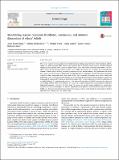| dc.contributor.author | Koster-Hale, Jorie | |
| dc.contributor.author | Richardson, Hilary | |
| dc.contributor.author | Velez, Natalia | |
| dc.contributor.author | Asaba, Mika | |
| dc.contributor.author | Young, Liane | |
| dc.contributor.author | Saxe, Rebecca R. | |
| dc.date.accessioned | 2020-05-26T14:48:47Z | |
| dc.date.available | 2020-05-26T14:48:47Z | |
| dc.date.issued | 2017-08 | |
| dc.date.submitted | 2017-03 | |
| dc.identifier.issn | 1053-8119 | |
| dc.identifier.uri | https://hdl.handle.net/1721.1/125446 | |
| dc.description.abstract | The human capacity to reason about others' minds includes making causal inferences about intentions, beliefs, values, and goals. Previous fMRI research has suggested that a network of brain regions, including bilateral temporo-parietal junction (TPJ), superior temporal sulcus (STS), and medial prefrontal-cortex (MPFC), are reliably recruited for mental state reasoning. Here, in two fMRI experiments, we investigate the representational content of these regions. Building on existing computational and neural evidence, we hypothesized that social brain regions contain at least two functionally and spatially distinct components: one that represents information related to others' motivations and values, and another that represents information about others' beliefs and knowledge. Using multi-voxel pattern analysis, we find evidence that motivational versus epistemic features are independently represented by theory of mind (ToM) regions: RTPJ contains information about the justification of the belief, bilateral TPJ represents the modality of the source of knowledge, and VMPFC represents the valence of the resulting emotion. These representations are found only in regions implicated in social cognition and predict behavioral responses at the level of single items. We argue that cortical regions implicated in mental state inference contain complementary, but distinct, representations of epistemic and motivational features of others' beliefs, and that, mirroring the processes observed in sensory systems, social stimuli are represented in distinct and distributed formats across the human brain. Keywords: Theory of mind; fMRI; Multi-voxel pattern analysis (MVPA) | en_US |
| dc.description.sponsorship | NSF Graduate Research Fellowships (Grant 0645960) | en_US |
| dc.description.sponsorship | NSF Graduate Research Fellowships (Grant 1122374) | en_US |
| dc.description.sponsorship | NSF CAREER award (Grant 095518) | en_US |
| dc.description.sponsorship | National Institutes of Health (Grant 1R01 MH096914-01A1) | en_US |
| dc.description.sponsorship | Packard Foundation (Grant 2008-333024) | en_US |
| dc.language.iso | en | |
| dc.publisher | Elsevier BV | en_US |
| dc.relation.isversionof | https://dx.doi.org/10.1016/j.neuroimage.2017.08.026 | en_US |
| dc.rights | Creative Commons Attribution-NonCommercial-NoDerivs License | en_US |
| dc.rights.uri | http://creativecommons.org/licenses/by-nc-nd/4.0/ | en_US |
| dc.source | Elsevier | en_US |
| dc.title | Mentalizing regions represent distributed, continuous, and abstract dimensions of others' beliefs | en_US |
| dc.type | Article | en_US |
| dc.identifier.citation | Koster-Hale, Jorie et al. "Mentalizing regions represent distributed, continuous, and abstract dimensions of others' beliefs." NeuroImage 161 (November 2017): 9-18. © 2017 The Author(s). | en_US |
| dc.contributor.department | Massachusetts Institute of Technology. Department of Brain and Cognitive Sciences | en_US |
| dc.relation.journal | NeuroImage | en_US |
| dc.eprint.version | Final published version | en_US |
| dc.type.uri | http://purl.org/eprint/type/JournalArticle | en_US |
| eprint.status | http://purl.org/eprint/status/PeerReviewed | en_US |
| dc.date.updated | 2019-10-03T18:19:18Z | |
| dspace.date.submission | 2019-10-03T18:19:22Z | |
| mit.journal.volume | 161 | en_US |
| mit.metadata.status | Complete | |
